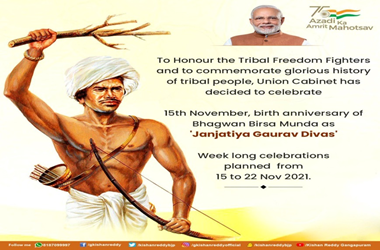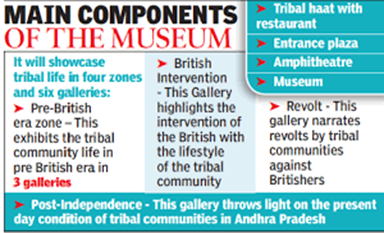Introduction
“Never Lose Faith on the destiny of India. There is no power which can keep India in Bondage”.
Tribal Freedom fighters prove this by fighting for their Rights as various tribal groups in India revolted against the forceful and devastating intrusions into their life and region by the British. The tribals had been living peacefully and in harmony with nature for hundreds of years in their own forests prior to the arrival of the colonial powers. The British came and introduced many changes in their way of life and also introduced outsiders into their turf. This reduced them to the status of labourers and debtors from masters of their own land. The uprisings were basically against this unwelcome intrusion and a fight for their independence.
Background
- The tribal communities have always been very conservative in nature and wanted to retain features of their society.
- Indian tribal uprisings, rebellions, and movements were motivated by revolutionary ideas.
- After the interference in their way of living, diverse tribal communities from various regions of India led a revolt against the exploitative and discriminatory practices of the British Indian Government during the time of British rule.
What were the causes of Tribal revolts during Colonial Rule?
- Introduction of Permanent Settlement in Agriculture: The tribals’ mainstay was agriculture, hunting, fishing and the use of forest produce. With the influx of non-tribals into the traditional regions of the tribals, the practice of settled agriculture was introduced.
- This led to a loss of land for the tribal population. The tribals were reduced to being landless agricultural labourers.
- Loss of livelihood: There were restrictions imposed on the use of forest produce, on shifting agriculture and on hunting practices. This led to the loss of livelihood for the tribals.
- Introduction of the outsiders: The British introduced outsiders like money lenders into the tribal areas which led to severe exploitation of the local tribals. They became bonded labourers under the new economic system.
- Private ownership by non-tribal landlords: The tribal societies had a system of joint ownership of land which was replaced by the notion of private property.
- Introduction of Forest Acts: A Forest Department was set up in 1864 by the government mainly to control the rich resources of Indian forests.
- Religious Conversions: The work of the Christian missionaries also led to social upheaval in tribal society and this was also resented by them as they considered the work of missionaries an extension of colonialism.
- Unregulated Tax Regime by Britishers: A section of the tribal rebellion was a response to the landlords’ attempts to impose taxes on the traditional use of timber and grazing areas, police exaction, new excise regulations, low country traders’ and moneylenders’ exploitation, and limitations on shifting agriculture in forests.
Phases of Tribal Uprising in India
The following three phases are used to categorise tribal movements. Mainly the Tribal uprisings took place during different phases of the freedom struggle. It lied in 18th, 19th and the 20th century.
- The First Phase (1795-1860): It happened at the same time as the British Empire’s emergence, growth, and establishment. The top class of tribal society, led by the traditional group whose privileges had been curtailed by colonialism in India, produced the leadership. Major tribal uprisings in this phase were: the Kols Uprising, Santhal uprising, Khond uprising and Early Munda uprising.
- The Second Phase (1860-1920): It includes the Koya Rebellion and the Birsamunda-led Munda Uprising.
- The Third Phase (1920-1947): It comprises the Chenchu tribal movement, the Rampa rebellion, and the Tanabhagat/Oraon Movement.
Some Major Tribal Uprisings
Santhal revolution
- On June 30, 1855, over 10,000 Santhals were mobilised by their leaders — Kanho Murmu, Chand Murmu, Bhairab Murmu and Sidho Murmu – to revolt against the East India Company over oppression by revenue officials, zamindars, and corrupt moneylenders.
- The seeds of the protracted rebellion, however, were sown in 1832 where the East India Company created Damin-i-koh region in the forested belt of Rajmahal hills, and invited the Santhals to settle there.
- Over the years, Santhals found themselves at the receiving end of exploitative practices aided by the British.
- After the rebellion broke out in 1855, both sides continued clashing till the uprising was crushed in
- The British defeated the Santhals using modern firearms and war elephants in decisive action in which both Sidho and Kanho died.
Paika rebellion
- In several recent descriptions, the 1817 Paika Rebellion in Odisha’s Khurda is referred to as the “original” first war of Indian Independence.
- That year, the Paikas – a class of military retainers traditionally recruited by the kings of Odisha – revolted against the British colonial rulers mainly over being dispossessed of their land holdings.
- In the run-up to the revolt, the British had dethroned and exiled the Khurda king in 1803, and then started introducing new revenue settlements.
Kol Mutiny
- The Kols, alongwith other tribes, are inhabitants of Chhotanagpur. This covered Ranchi, Singhbhum, Hazaribagh, Palamau and the western parts of Manbhum.
- The trouble in 1831 started with large-scale transfers of land from Kol headmen to outsiders like Hindu, Sikh and Muslim farmers and money-lenders who were oppressive and demanded heavy taxes.
- The Kols resented this and in 1831, under the leadership of Buddho Bhagat, the Kol rebels killed or burnt about a thousand outsiders.
- Only after large-scale military operations order was restored.
Bhil uprising
- After the British intruded into the Bhil territory in Maharashtra’s Khandesh region, the tribals pushed back fearing exploitation under the new regime in 1818.
- The revolt was led by their leader, Sewaram and was brutally crushed using the British military might.
- This uprising again erupted in 1825 as the Bhils sought to take advantage of reverses being suffered by the British in the first Anglo-Burmese war.
Ramosi Uprising
- Ramosi Uprising was a Tribal peasant revolt (1877-1887; Maharashtra) against the British failure to take up anti-famine measures.
- It was led by Vasudev Balwant Phadke. It was protested in the violent manner not in the peaceful manner.
Rampa Rebellion
- The Rampa Rebellion of 1922, also known as the Manyam Rebellion, was a tribal uprising led by Alluri Sitarama Rajuin Godavari Agency of Madras Presidency, British India.
- It began in August 1922 and lasted until the capture and killing of Raju in May 1924.
Impact of Tribal Revolts during Freedom Struggle
- Politico- Religious impacts: Religious conversions by Christian Missionaries were at the top at that time. Britishers tried to convert innocent Tribals to Christianity.
- Revolts brought aggression of tribals against these religious conversions and conserved India to lose its Cultural identity.
- Social Impacts: Tribals were used to live in groups and follow their own way of living. British policies started interfering in their way of living.
- Tribal revolts made Britishers understand the importance of India’s Cultural Diversity and its significance for their people.
- Economic Impact: The Government Forest Act of 1865 and the Indian Forest Act of 1878 established a complete government monopoly over the forested land.
- The Tribal revolt has drawn the attention of exploitative British policies for forests resources.
- Initiated a local Freedom spirit: Tribal revolts bring into attention of people that fight for independence should not just the task of few leaders but the responsibility of even the common individual and which is possible too.

|
Recent Initiatives for Freedom fighters
- Tribal Haat
- Jallainwala Bagh renovation remembering Freedom fighters.
- Some Tribal freedom fighters:
- India’s freedom struggle was strengthened by several movements by tribal communities such as Santhals, Tamars, Kols, Bhils, Khasis and Mizos.

- Birsa Munda: spearheaded an Indian tribal religious Millenarian movement during British rule in the late 19th century across the tribal belt of modern-day Jharkhand and Bihar.
- Shaheed Veer Narayan Singh: considered the Pride of Sonakhan in Chhattisgarh, he looted trader’s grain stock and distributed them amongst the poor after the 1856 famine. He became the first martyr from Chhattisgarh in the independence struggle of 1857.
- Shri Alluri Seetha Ram Raju: Best remembered for leading the Rampa Rebellion against the British in which he organised the tribal people of Visakhapatnam and East Godavari districts to revolt against the foreigners.
- Rani Gaidinliu: was a Naga spiritual and political leader who led a revolt against British rule in India.
- Sidhu and Kanhu Murmu: organised 10,000 Santhals and proclaimed a rebellion against the British.
|
What were the reasons for the decline of the Tribal revolts?
As Tribal revolts remained confined to the era between 18th and early 19th Century, they contributed to the very beginning of the aggression for British Raj. They revolted not against the British but their policy for Indian’s which were imposed on them without even knowing their culture and its significance.
Later this led to the revolt of 1857, which took attention of all over the country. Hence these are the following major reasons for decline of Tribal revolts:
- Revolts were Confined to a particular region and where unable to spread all over the country.
- Specific issues of Tribes were different from the mainstream population and hence they were unable to relate to their problems for invoking a feeling of aggression against Britishers.
- Lack of a leader: Most of the Tribal revolts were under no leadership and thus it remained hostile after some time.
Conclusion
The Indian independence movement was a great movement by various people from nooks and corners of the country. They had sacrificed their lives and soul for the independence of their country. There are numerous freedom fighters in India who have fought against British rule in which Tribal revolts were among them. Their contribution is unforgettable and remained in the pages of History against the British Raj.
